5 Out-of-this-world Facts About Our Iconic Vehicle Assembly Building!
5 Out-of-this-world Facts About Our Iconic Vehicle Assembly Building!

The Vehicle Assembly Building, or VAB, at our Kennedy Space Center in Florida, is the only facility where assembly of a rocket occurred that carried humans beyond low-Earth orbit and on to the Moon. For 30 years, its facilities and assets were used during the Space Shuttle Program and are now available to commercial partners as part of our agency’s plan in support of a multi-user spaceport. To celebrate the VAB’s continued contribution to humanity’s space exploration endeavors, we’ve put together five out-of-this-world facts for you!
1. It’s one of the largest buildings in the world by area, the VAB covers eight acres, is 525 feet tall and 518 feet wide.

Aerial view of the Vehicle Assembly Building with a mobile launch tower atop a crawler transporter approaching the building.
2. The VAB was constructed for the assembly of the Apollo/Saturn V Moon rocket, the largest rocket made by humans at the time.

An Apollo/Saturn V facilities Test Vehicle and Launch Umbilical Tower (LUT) atop a crawler-transporter move from the Vehicle Assembly Building (VAB) on the way to Pad A on May 25, 1966.
3. The building is home to the largest American flag, a 209-foot-tall, 110-foot-wide star spangled banner painted on the side of the VAB.

Workers painting the Flag on the Vehicle Assembly Building on January 2, 2007.
4. The tallest portions of the VAB are its 4 high bays. Each has a 456-foot-high door. The doors are the largest in the world and take about 45 minutes to open or close completely.

A mobile launcher, atop crawler-transporter 2, begins the move into High Bay 3 at the Vehicle Assembly Building (VAB) on Sept. 8, 2018.
5. After spending more than 50 years supporting our human spaceflight programs, the VAB received its first commercial tenant – Northrop Grumman Corporation – on August 16, 2019!

A model of Northrop Grumman’s OmegA launch vehicle is flanked by the U.S. flag and a flag bearing the OmegA logo during a ribbon-cutting ceremony Aug. 16 in High Bay 2 of the Vehicle Assembly Building.
Whether the rockets and spacecraft are going into Earth orbit or being sent into deep space, the VAB will have the infrastructure to prepare them for their missions.
Make sure to follow us on Tumblr for your regular dose of space: http://nasa.tumblr.com.
More Posts from Nasa and Others
Hello!! Its wonderful to be able to ask questions, thank you!
About Perseverance, does it have a self-repair option? And as Curiosity is still operational, will they run missions together? Or will they split up to cover more distance?
Is this a sign that we're close to being able to set foot on Mars?
My final question is how do you receive the messages from such a long distance?
Thanks for all your hard work! 加油/Good luck!
“Is this a sign that we are close to being able to set foot on Mars?”
Seven Years of Tracking the Solar Cycle
Our sun is ever-changing, and a satellite called the Solar Dynamics Observatory has a front-row seat.

On February 11, 2010, we launched the Solar Dynamics Observatory, also known as SDO. SDO keeps a constant eye on the sun, helping us track everything from sunspots to solar flares to other types of space weather that can have an impact on Earth.
After seven years in space, SDO has had a chance to do what few other satellites have been able to do – watch the sun for the majority of a solar cycle in 11 types of light.

The sun’s activity rises and falls in a pattern that lasts about 11 years on average. This is called the solar cycle.
Solar activity can influence Earth. For instance, it’s behind one of Earth’s most dazzling natural events – the aurora.

One of the most common triggers of the aurora is a type of space weather called a coronal mass ejection, which is a billion-ton cloud of magnetic solar material expelled into space at around a million miles an hour.

When these clouds collide with Earth’s magnetic field, they can rattle it, sending particles down into the atmosphere and triggering the auroras. These events can also cause satellite damage and power grid strain in extreme cases.
The sun is in a declining activity phase, so coronal mass ejections will be less common over the next few years, as will another one of the main indicators of solar activity – sunspots.

Sunspots are created by twisted knots of magnetic field. Solar material in these tangled regions is slightly cooler than the surrounding areas, making them appear dark in visible light.

The tangled magnetic field that creates sunspots also causes most solar activity, so more sunspots means more solar activity, and vice versa. Humans have been able to track the solar cycle by counting sunspots since the 17th century.

Image: Houghton Library, Harvard University, *IC6.G1333.613ia
The peak of the sun’s activity for this cycle, called solar maximum, was in 2014.

Now, we’re heading towards the lowest solar activity for this solar cycle, also known as solar minimum. As solar activity declines, the number of sunspots decreases. We sometimes go several days without a single visible sunspot.

But there’s much more to the story than sunspots – SDO also watches the sun in a type of light called extreme ultraviolet. This type of light is invisible to human eyes and is blocked by our atmosphere, so we can only see the sun this way with satellites.

Extreme ultraviolet light reveals different layers of the sun’s atmosphere, helping scientists connect the dots between the sunspots that appear in visible light and the space weather that impacts us here on Earth.
SDO keeps an eye on the sun 24/7, and you can see near real-time images of the sun in 11 types of light at sdo.gsfc.nasa.gov/data.
How Do Space Telescopes Break Down Light?
Space telescopes like Hubble and our upcoming James Webb Space Telescope use light not only to create images, but can also break light down into individual colors (or wavelengths). Studying light this way can give us a lot of detail about the object that emitted that light. For example, studying the components of the light from exoplanets can tell us about its atmosphere’s color, chemical makeup, and temperature. How does this work?
Remember the primary colors you learned about in elementary school?
Those colors are known as the pigment or subtractive colors. Every other color is some combination of the primary colors: red, yellow, and blue.

Light also has its own primary colors, and they work in a similar way. These colors are known as additive or light colors.
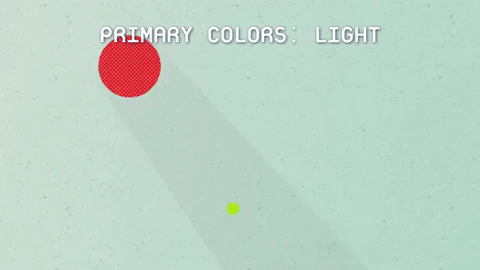
TVs make use of light’s colors to create the pictures we see. Each pixel of a TV screen contains some amount of red, green and blue light. The amount of each light determines the overall color of the pixel. So, each color on the TV comes from a combination of the primary colors of light: red, green and blue.

Space telescope images of celestial objects are also a combination of the colors of light.
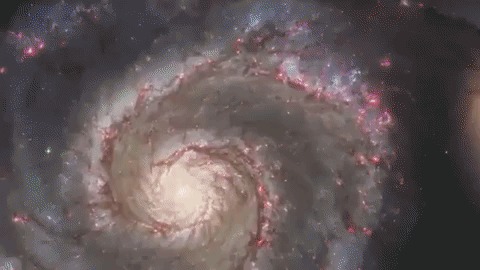
Every pixel that is collected can be broken down into its base colors. To learn even more, astronomers break the red, green and blue light down into even smaller sections called wavelengths.
This breakdown is called a spectrum.
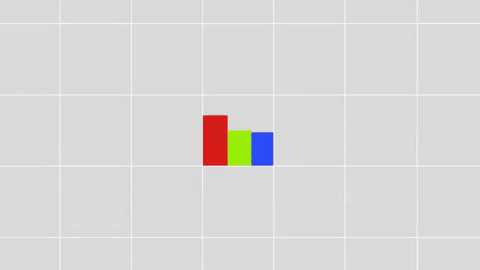
With the right technology, every pixel of light can also be measured as a spectrum.

Images show us the big picture, while a spectrum reveals finer details. Astronomers use spectra to learn things like what molecules are in planet atmospheres and distant galaxies.
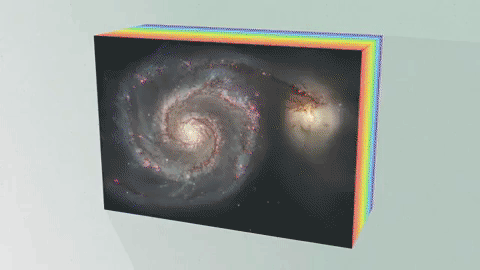
An Integral Field Unit, or IFU, is a special tool on the James Webb Space Telescope that captures images and spectra at the same time.
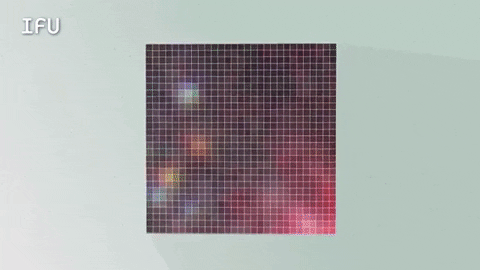
The IFU creates a unique spectrum for each pixel of the image the telescope is capturing, providing scientists with an enormous amount of valuable, detailed data. So, with an IFU we can get an image, many spectra and a better understanding of our universe.
Watch the full video where this method of learning about planetary atmospheres is explained:
The James Webb Space Telescope is our upcoming infrared space observatory, which will launch in 2021. It will spy the first galaxies that formed in the universe and shed light on how galaxies evolve, how stars and planetary systems are born and tell us about potentially habitable planets around other stars.
To learn more about NASA’s James Webb Space Telescope, visit the website, or follow the mission on Facebook, Twitter and Instagram.
Text and graphics credit: Space Telescope Science Institute
Make sure to follow us on Tumblr for your regular dose of space: http://nasa.tumblr.com.
How does time work in a black hole?

Spectacular death. Spectacular star. Your crushed heart remains bright from afar. You’re looking at a composite image of the Crab Nebula, located 6,500 light-years away. The white dot in the center — an extremely dense ball of neutrons just 12 miles across but with the same mass as our Sun — is all that remains from a star that exploded in 1054 A.D. Had the blast occurred 50 light-years away, its intense radiation would have wiped out most life forms on Earth. Spectacular death. Spectacular star. We’re grateful we can admire you from afar.
6 Ways You Are Safer Thanks to NASA Technology
By now everyone knows that we are to thank for the memory foam in your mattress and the camera in your cell phone. (Right? Right.)
But our technology is often also involved behind the scenes—in ways that make the products we use daily safer and stronger, and in some cases, that can even save lives.
Here are some examples from this year’s edition of Spinoff, our yearly roundup of “space in your life”:
Impact Testing

What happens to your car bumper in an accident? When does it crumple and when does it crack? And are all bumpers coming off the assembly line created equal?
These types of questions are incredibly important when designing a safe car, and one technology that helps almost every U.S. automobile manufacturer find answers is something we helped develop when we had similar questions about the Space Shuttle.
Before flying again after the Columbia disaster in 2003, we had to be sure we understood what went wrong and how to prevent it from ever happening again. We worked with Trilion, Inc. to develop a system using high-speed cameras and software to analyze every impact—from the one that actually happened on the Shuttle to any others we could imagine—and design fixes.
Finding Survivors

We’re pretty good at finding things you can’t see with the naked eye—from distant exoplanets to water on Mars.
But there are also plenty of uses for that know-how on Earth.
One example that has already saved lives: locating heartbeats under debris.
Engineers at our Jet Propulsion Laboratory adapted technology first devised to look for gravity fluctuations to create FINDER, which stands for Finding Individuals for Disaster and Emergency Response and can detect survivors through dense rubble.
We have licensed the technology to two companies, including R4, and it has already been used in natural disaster responses, including after earthquakes in Nepal, Mexico City, Ecuador, and after Hurricane Maria in Puerto Rico.
Fighting Forest Fires

As we have seen this year with devastating wildfires in California, forest fires can spread incredibly quickly.
Knowing when to order an evacuation, where to send firefighters, and how to make every other decision—all amid a raging inferno—depends on having the most up-to-date information as quickly as possible.
Using our expertise in remote sensing and communicating from space, we helped the U.S. Forest Service make its process faster and more reliable, so the data from airborne sensors gets to decision makers on the front line and at the command center in the blink of an eye.
Safer, Germ-Free Ambulances

When paramedics come racing into a home, the last thing anybody is worrying about is where the ambulance was earlier that morning. A device we helped create ensures you won’t have to.
AMBUstat creates a fog that sterilizes every surface in an ambulance in minutes, so any bacteria, viruses or other contaminants won’t linger on to infect the next patient.
This technology works its magic through the power of atomic oxygen—the unpaired oxygen atoms that are common in the upper reaches of Earth’s atmosphere. We’ve had to learn about these atoms to devise ways to ensure they won’t destroy our spacecraft or harm astronauts, but here, we were able to use that knowledge to direct that destructive power at germs.
Air Filters

Did you know the air we breathe inside buildings is often up to 10 times more polluted than the air outdoors?
Put the air under a microscope and it’s not pretty, but a discovery we made in the 1990s can make a big impact.
We were working on a way to clear a harmful chemical that accumulates around plants growing on a spacecraft, and it turned out to also neutralize bacteria, viruses, and mold and eliminate volatile organic compounds.
Now air purifiers using this technology are deployed in hospital operating rooms, restaurant kitchens, and even major baseball stadiums to improve air quality and keep everyone healthier. Oh, and you can buy one for your house, too.
Driverless Cars

Car companies are moving full-speed ahead to build the driverless cars of the not-so-distant future. Software first created to help self-learning robots navigate on Mars may help keep passengers and pedestrians safer once those cars hit the road. The software creates an artificially intelligent “brain” for a car (or drone, for that matter) that can automatically identify and differentiate between cars, trucks, pedestrians, cyclists, and more, helping ensure the car doesn’t endanger any of them.
So, now that you know a few of the spinoff technologies that we helped develop, you can look for them throughout your day. Visit our page to learn about more spinoff technologies: https://spinoff.nasa.gov Make sure to follow us on Tumblr for your regular dose of space: http://nasa.tumblr.com.
Sing About NASA with Our Interns
Each semester, interns at Johnson Space Center (JSC) have the opportunity to contribute to our agency’s missions and help us lead the frontier of human space exploration. Interns at JSC also have the opportunity to enhance their experience through weekly meetings to discuss social and professional development topics, and can also get involved in many different committees.
The intern video committee from each semester comes up with ideas and carries out the entire process of creating a video that puts a creative, youthful spin on spreading NASA messages.
Here are a few highlights from some of the great intern videos that have been created:
Welcome to NASA
“Welcome to NASA” is based off of Flo Rida’s “My House” and was created to raise interest for our Journey to Mars. The lyrics and scenes in the video have been re-imagined in order to inform the public about the amazing work going on at NASA and the Johnson Space Center.
Created in 2016
NASA is Good
This latest intern video is based off of Andy Grammer’s “Honey, I’m Good”. This video is designed as an outreach video to raise interest around the One-Year Mission aboard the International Space Station and the Pathways and Student Intern opportunities.
Created in 2015
NASA Johnson Style
NASA Johnson Style was created as an educational parody of Psy’s "Gangnam Style". The intent of the video is to inform the public about the work being done at Johnson Space Center and throughout the agency.
Created in 2012
I.S.S. Baby
A group of NASA interns collaborated to create the I.S.S Baby video based off of Vanilla Ice’s “Ice, Ice, Baby”. The video was designed as an outreach video to raise interest around the International Space Station.
Created in 2008
There are plenty more JSC intern videos. You can watch more and learn about the work done at JSC and throughout the agency HERE.
Make sure to follow us on Tumblr for your regular dose of space: http://nasa.tumblr.com
How Gravity Warps Light
Gravity is obviously pretty important. It holds your feet down to Earth so you don’t fly away into space, and (equally important) it keeps your ice cream from floating right out of your cone! We’ve learned a lot about gravity over the past few hundred years, but one of the strangest things we’ve discovered is that most of the gravity in the universe comes from an invisible source called “dark matter.” While our telescopes can’t directly see dark matter, they can help us figure out more about it thanks to a phenomenon called gravitational lensing.
The Gravity of the Situation
Anything that has mass is called matter, and all matter has gravity. Gravity pulls on everything that has mass and warps space-time, the underlying fabric of the universe. Things like llamas and doughnuts and even paper clips all warp space-time, but only a tiny bit since they aren’t very massive.

But huge clusters of galaxies are so massive that their gravity produces some pretty bizarre effects. Light always travels in a straight line, but sometimes its path is bent. When light passes close to a massive object, space-time is so warped that it curves the path the light must follow. Light that would normally be blocked by the galaxy cluster is bent around it, producing intensified — and sometimes multiple — images of the source. This process, called gravitational lensing, turns galaxy clusters into gigantic, intergalactic magnifying glasses that give us a glimpse of cosmic objects that would normally be too distant and faint for even our biggest telescopes to see.

Hubble “Sees” Dark Matter
Let’s recap — matter warps space-time. The more matter, the stronger the warp and the bigger its gravitational lensing effects. In fact, by studying “lensed” objects, we can map out the quantity and location of the unseen matter causing the distortion!
Thanks to gravitational lensing, scientists have measured the total mass of many galaxy clusters, which revealed that all the matter they can see isn’t enough to create the warping effects they observe. There’s more gravitational pull than there is visible stuff to do the pulling — a lot more! Scientists think dark matter accounts for this difference. It’s invisible to our eyes and telescopes, but it can’t hide its gravity!
The mismatch between what we see and what we know must be there may seem strange, but it’s not hard to imagine. You know that people can’t float in mid-air, so what if you saw a person appearing to do just that? You would know right away that there must be wires holding him up, even if you couldn’t see them.

Our Hubble Space Telescope observations are helping unravel the dark matter mystery. By studying gravitationally lensed galaxy clusters with Hubble, astronomers have figured out how much of the matter in the universe is “normal” and how much is “dark.” Even though normal matter makes up everything from pickles to planets, there’s about five times more dark matter in the universe than all the normal matter combined!
WFIRST Will Escalate the Search
One of our next major space telescopes, the Wide Field Infrared Survey Telescope (WFIRST), will take these gravitational lensing observations to the next level. WFIRST will be sensitive enough to use weak gravitational lensing to see how clumps of dark matter warp the appearance of distant galaxies. By observing lensing effects on this small scale, scientists will be able to fill in more of the gaps in our understanding of dark matter.
WFIRST will observe a sky area 100 times larger than Hubble does, but with the same awesome image quality. WFIRST will collect so much data in its first year that it will allow scientists to conduct in-depth studies that would have taken hundreds of years with previous telescopes.

WFIRST’s weak gravitational lensing observations will allow us to peer even further back in time than Hubble is capable of seeing. Scientists believe that the universe’s underlying dark matter structure played a major role in the formation and evolution of galaxies by attracting normal matter. Seeing the universe in its early stages will help scientists unravel how it has evolved over time and possibly provide clues to how it may continue to evolve. We don’t know what the future will hold, but WFIRST will help us find out.

This science is pretty mind-bending, even for scientists. Learn more as our current and future telescopes plan to help unlock these mysteries of the universe...
Hubble: https://www.nasa.gov/mission_pages/hubble/main/index.html WFIRST: https://wfirst.gsfc.nasa.gov/
Make sure to follow us on Tumblr for your regular dose of space: http://nasa.tumblr.com
Chasing the Shadow of Neptune’s Moon Triton
Our Flying Observatory

Our flying observatory, called SOFIA, carries a 100-inch telescope inside a Boeing 747SP aircraft. Scientists onboard study the life cycle of stars, planets (including the atmosphere of Mars and Jupiter), nearby planetary systems, galaxies, black holes and complex molecules in space.
AND on Oct. 5, SOFIA is going on a special flight to chase the shadow of Neptune's moon Triton as it crosses Earth’s surface!
In case you’re wondering, SOFIA stands for: Stratospheric Observatory for Infrared Astronomy.
Triton

Triton is 1,680 miles (2,700 km) across, making it the largest of the 13 moons orbiting Neptune. Unlike most large moons in our solar system, Triton orbits in the opposite direction of Neptune, called a retrograde orbit. This backward orbit leads scientists to believe that Triton formed in an area past Neptune, called the Kuiper Belt, and was pulled into its orbit around Neptune by gravity.
The Voyager 2 spacecraft flew past Neptune and Triton in 1989 and found that Triton’s atmosphere is made up of mostly nitrogen...but it has not been studied in nearly 16 years!
Occultations are Eclipse-Like Events

An occultation occurs when an object, like a planet or a moon, passes in front of a star and completely blocks the light from that star. As the object blocks the star’s light, it casts a faint shadow on Earth’s surface.
But unlike an eclipse, these shadows are not usually visible to the naked eye because the star and object are much smaller and not nearly as bright as our sun. Telescopes with special instruments can actually see these shadows and study the star’s light as it passes near and around the object – if they can be in the right place on Earth to catch the shadow.
Chasing Shadows

Scientists have been making advanced observations of Triton and a background star. They've calculated exactly where Triton’s faint shadow will fall on Earth! Our SOFIA team has designed a flight path that will put SOFIA (the telescope and aircraft) exactly in the center of the shadow at the precise moment that Triton and the star will align.
This is no easy feat because the shadow is moving at more than 53,000 mph while SOFIA flies at Mach 0.85 (652 mph), so we only have about two minutes to catch the shadow!! But our SOFIA team has previously harnessed the aircraft’s mobility to study Pluto from inside the center of its occultation shadow, and is ready to do it again to study Triton!
What We Learn From Inside the Shadow

From inside the shadow, our team on SOFIA will study the star’s light as it passes around and through Triton’s atmosphere. This allows us to learn more about Triton’s atmosphere, including its temperature, pressure, density and composition!
Our team will use this information to examine if Triton’s atmosphere has changed since our Voyager 2 spacecraft flew past it in 1989. That’s a lot of information from a bit of light inside a shadow! Similar observations of Uranus in 1977, from our previous flying observatory, led to the discovery of rings around that planet!
International Ground-Based Support

Ground-based telescopes across the United States and Europe – from Scotland to the Canary Islands – will also be studying Triton’s occultation. Even though most of these telescopes will not be in the center of the shadow, the simultaneous observations, from different locations on Earth, will give us information about how Triton’s atmosphere varies across its latitudes.
This data from across the Earth and from onboard SOFIA will help researchers understand how Triton’s atmosphere is distorted at different locations by its high winds and its strong tides!
Make sure to follow us on Tumblr for your regular dose of space: http://nasa.tumblr.com.
A Total Lunar Eclipse is Coming: 10 Things to Know
If you were captivated by August's total solar eclipse, there's another sky show to look forward to on Jan. 31: a total lunar eclipse!

Below are 10 things to know about this astronomical event, including where to see it, why it turns the Moon into a deep red color and more...
1. First things first. What's the difference between solar and lunar eclipses? We've got the quick and easy explanation in this video:
2. Location, location, location. What you see will depend on where you are. The total lunar eclipse will favor the western U.S., Alaska, Hawaii, and British Columbia on Jan. 31. Australia and the Pacific Ocean are also well placed to see a major portion of the eclipse, if not all of it.

3. Color play. So, why does the Moon turn red during a lunar eclipse? Here's your answer:
4. Scientists, stand by. What science can be done during a lunar eclipse? Find out HERE.
5. Show and tell. What would Earth look like from the Moon during a lunar eclipse? See for yourself with this artist's concept HERE.
6. Ask me anything. Mark your calendars to learn more about the Moon during our our Reddit AMA happening Monday, Jan. 29, from 3-4 pm EST/12-1 pm PST.

7. Social cues. Make sure to follow @NASAMoon and @LRO_NASA for all of the latest Moon news leading up to the eclipse and beyond.
8. Watch year-round. Can't get enough of observing the Moon? Make a DIY Moon Phases Calendar and Calculator that will keep all of the dates and times for the year's moon phases right at your fingertips HERE.

Then, jot down notes and record your own illustrations of the Moon with a Moon observation journal, available to download and print from moon.nasa.gov.
9. Lesson learned. For educators, pique your students' curiosities about the lunar eclipse with this Teachable Moment HERE.
10. Coming attraction. There will be one more lunar eclipse this year on July 27, 2018. But you might need your passport—it will only be visible from central Africa and central Asia. The next lunar eclipse that can be seen all over the U.S. will be on Jan. 21, 2019. It won't be a blue moon, but it will be a supermoon.
Make sure to follow us on Tumblr for your regular dose of space: http://nasa.tumblr.com.
-
 beyondafinecupofcoffee liked this · 1 year ago
beyondafinecupofcoffee liked this · 1 year ago -
 stinkyrat09 liked this · 3 years ago
stinkyrat09 liked this · 3 years ago -
 highclassassmel liked this · 4 years ago
highclassassmel liked this · 4 years ago -
 lolagonnamakeit liked this · 4 years ago
lolagonnamakeit liked this · 4 years ago -
 hano-orion liked this · 4 years ago
hano-orion liked this · 4 years ago -
 hippiebydayrickymartin reblogged this · 4 years ago
hippiebydayrickymartin reblogged this · 4 years ago -
 ijustwannnasleep liked this · 4 years ago
ijustwannnasleep liked this · 4 years ago -
 karchuckles liked this · 5 years ago
karchuckles liked this · 5 years ago -
 zephyr-of-the-south liked this · 5 years ago
zephyr-of-the-south liked this · 5 years ago -
 velvetsunset reblogged this · 5 years ago
velvetsunset reblogged this · 5 years ago -
 dancergrl1 liked this · 5 years ago
dancergrl1 liked this · 5 years ago -
 razzorpink reblogged this · 5 years ago
razzorpink reblogged this · 5 years ago -
 dcjokerhs liked this · 5 years ago
dcjokerhs liked this · 5 years ago -
 sororia04s liked this · 5 years ago
sororia04s liked this · 5 years ago -
 may-emerald liked this · 5 years ago
may-emerald liked this · 5 years ago -
 keanushii liked this · 5 years ago
keanushii liked this · 5 years ago -
 sourpatchthief16 reblogged this · 5 years ago
sourpatchthief16 reblogged this · 5 years ago -
 sourpatchthief16 liked this · 5 years ago
sourpatchthief16 liked this · 5 years ago -
 tmifangirl29 liked this · 5 years ago
tmifangirl29 liked this · 5 years ago -
 meralasan liked this · 5 years ago
meralasan liked this · 5 years ago -
 si1verstarr reblogged this · 5 years ago
si1verstarr reblogged this · 5 years ago -
 si1verstarr liked this · 5 years ago
si1verstarr liked this · 5 years ago -
 mynewpossibility liked this · 5 years ago
mynewpossibility liked this · 5 years ago -
 keep-a-bucket-full-of-stars reblogged this · 5 years ago
keep-a-bucket-full-of-stars reblogged this · 5 years ago -
 keep-a-bucket-full-of-stars liked this · 5 years ago
keep-a-bucket-full-of-stars liked this · 5 years ago -
 agentemp4 liked this · 5 years ago
agentemp4 liked this · 5 years ago -
 ferociousqueak liked this · 5 years ago
ferociousqueak liked this · 5 years ago -
 fourthage reblogged this · 5 years ago
fourthage reblogged this · 5 years ago -
 linear-algebruh liked this · 5 years ago
linear-algebruh liked this · 5 years ago -
 pinkiepieaddict reblogged this · 5 years ago
pinkiepieaddict reblogged this · 5 years ago -
 liliumnnavona liked this · 5 years ago
liliumnnavona liked this · 5 years ago -
 getsmashed liked this · 5 years ago
getsmashed liked this · 5 years ago -
 princessofimladris liked this · 5 years ago
princessofimladris liked this · 5 years ago -
 fellowitch liked this · 5 years ago
fellowitch liked this · 5 years ago
Explore the universe and discover our home planet with the official NASA Tumblr account
1K posts